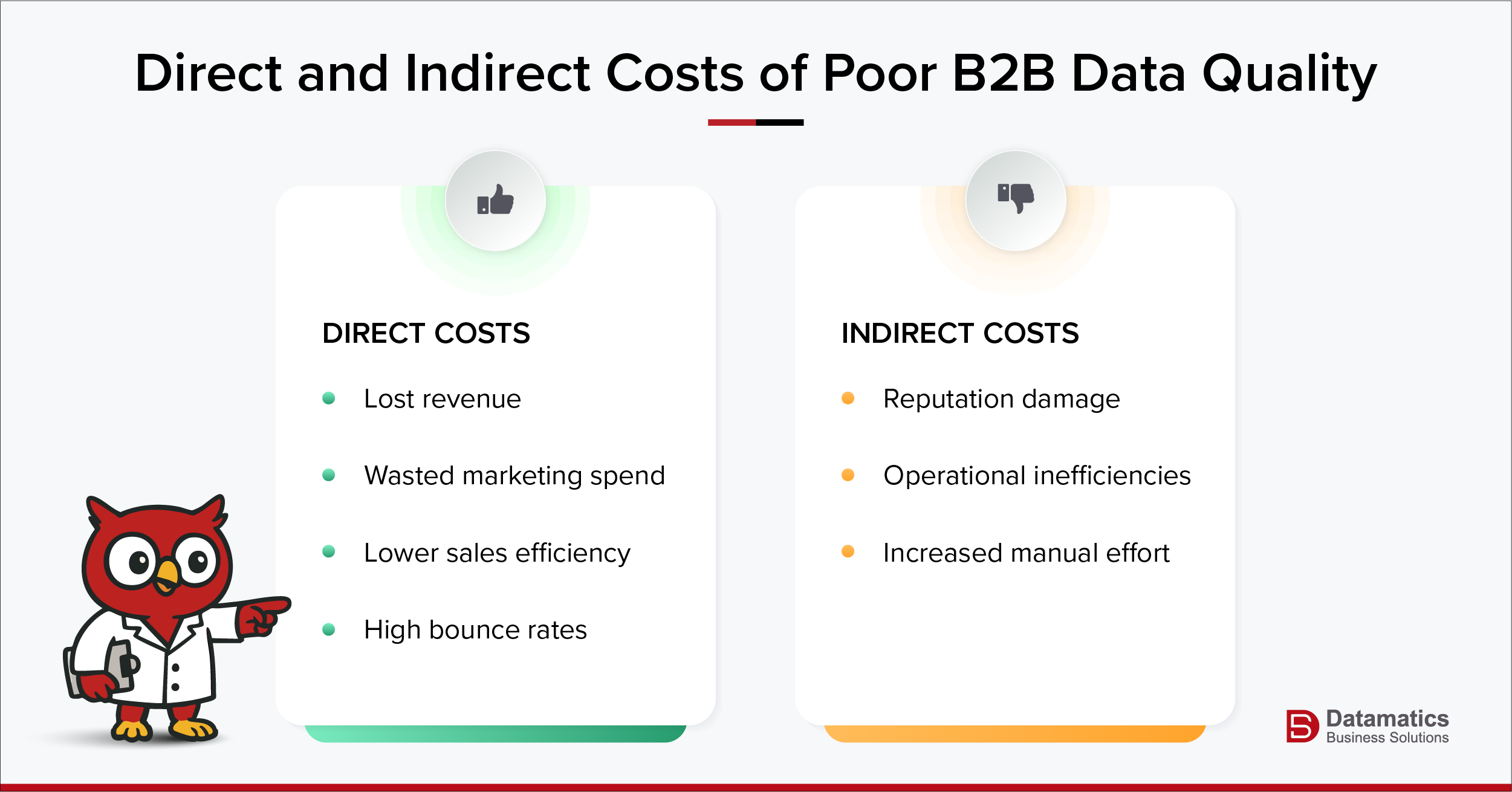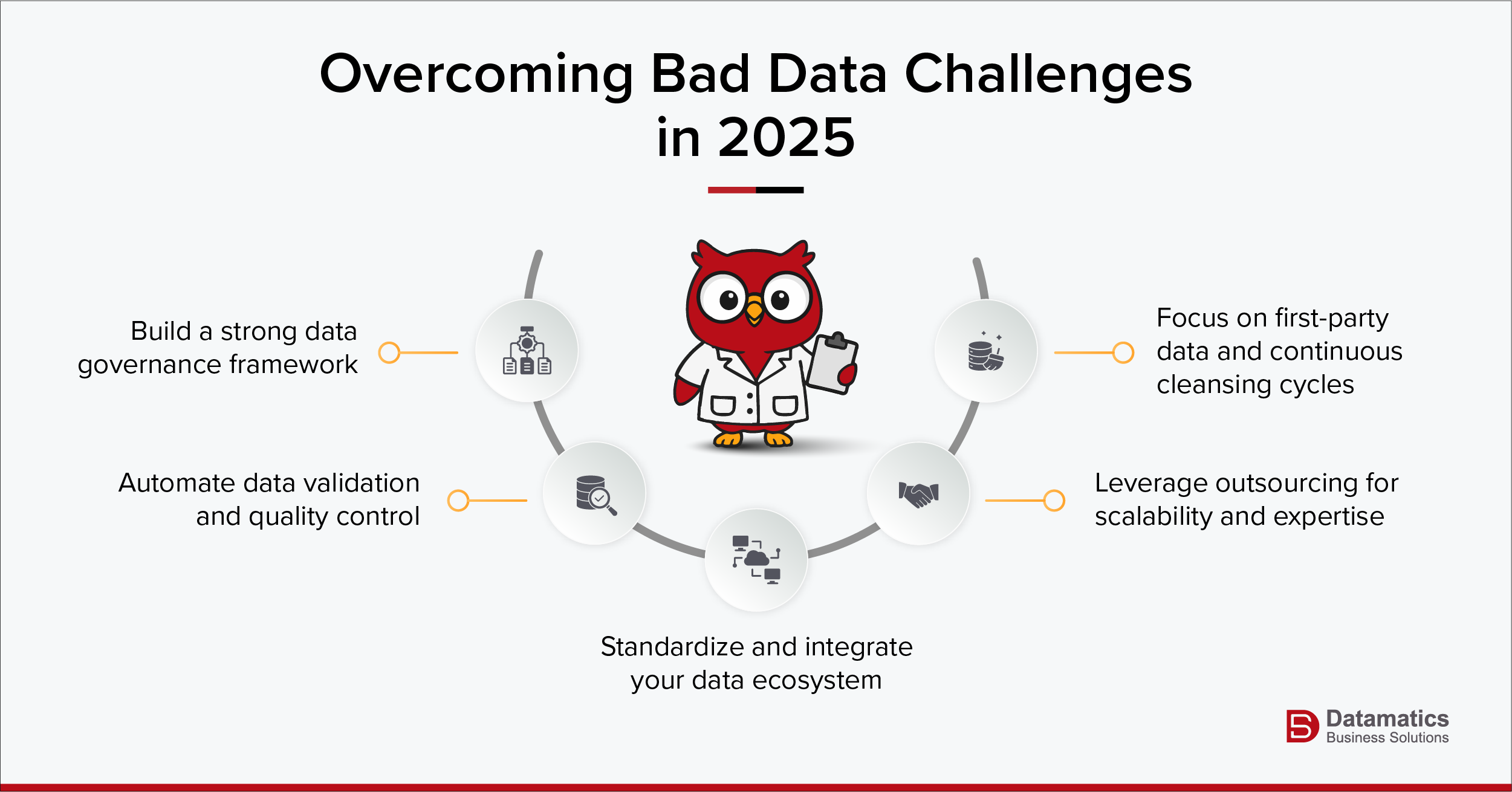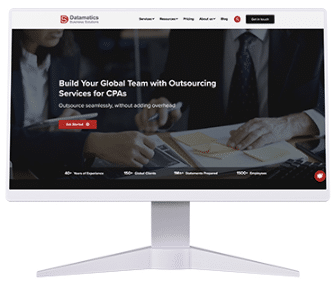Bad data is one of the biggest barriers to effective B2B sales and marketing.
It slows down pipelines, inflates campaign costs, and leads to poor decisions based on unreliable insights. Over time, these issues compound, hurting performance, compliance, and revenue.
This article dives into the concept of how structured, continuous data cleansing transforms bad data into a reliable foundation for growth.
Scroll below to learn how data cleansing services actually work, the benefits, and how you can overcome poor data quality challenges, including how Datamatics help businesses maintain accurate, compliant, and high-performing databases
What is B2B Data Cleansing or Data Scrubbing?
B2B data cleansing is the process of identifying, correcting, and removing errors in business databases to keep records accurate, complete, and ready for use. It ensures every contact, account, and lead in a CRM or marketing platform is valid and consistent.
The process includes fixing typos, removing duplicate entries, updating outdated contact information, and standardizing formats such as addresses and phone numbers. Many data cleansing companies use automation and AI-based validation to speed up this process and improve accuracy.
This Reddit response breaks down what data cleansing means for B2B in the simplest of manners:

The Cost of Bad Data in B2B Databases
According to Gartner, organizations believe poor data quality to be responsible for an average of $15 million per year in losses.
Bad data in B2B databases directly impacts revenue, productivity, and compliance. When records are outdated or inconsistent, teams waste time chasing invalid leads, campaigns underperform, and strategic decisions become unreliable.
Typical examples include sales teams calling the wrong contacts, email campaigns bouncing, and ABM programs targeting irrelevant accounts. Over time, these issues erode credibility, inflate marketing spend, and create friction across sales and marketing operations.
Here are some of the direct and indirect costs of bad data quality in B2B:

Lost revenue: Bad data can cost companies up to 25% of their potential revenue.
Wasted marketing spend: Inaccurate contact details lead to ineffective campaigns and poor ROI.
Lower sales efficiency: Reps spend 70% of their time on nonselling tasks such as verifying contact details, correcting CRM entries, and following up with invalid leads—significantly reducing productive selling time and increasing cost per lead
High bounce rates: Incorrect or outdated email addresses damage sender reputation and lower campaign performance. In fact, email data quality issues impact nearly 9% of businesses the most, primarily due to invalid or obsolete addresses that hinder deliverability and engagement.
Reputation damage: Wrong contacts or irrelevant outreach hurt brand credibility.
Operational inefficiencies: Errors and inconsistencies increase confusion, costs, and decision-making delays.
Increased manual effort: Teams spend additional hours cleaning and verifying records instead of selling or strategizing.
And many more.
You may be interested in exploring this guide where we’ve broken down the actual cost of bad data and its impact, including what exactly constitutes bad B2B data quality and how you fix it.
Going forward, bad data not only weakens campaign performance but also exposes firms to regulatory risks under GDPR, CCPA, and CAN-SPAM. Continuous data cleansing helps maintain data quality, ensuring accuracy, compliance, and measurable improvements in marketing ROI.
Let’s understand how it works in practice.
How do the B2B data cleansing services work?
B2B data cleansing services offer a structured and repeatable method to keep business data accurate, consistent, and usable. It focuses on identifying and correcting errors, removing duplicates, and updating outdated records across CRMs, marketing systems, and enterprise databases.

B2B data cleansing isn’t a one-time clean-up. It’s an ongoing process that keeps your data usable, reliable, and business-ready while operations continue running at full speed.
Think of it less like following a perfect recipe and more like baking a cake while the oven’s still hot. You’re constantly refining, checking, and improving as business data keeps pouring in from multiple systems.
Just like baking, success depends on precision, timing, and consistency. Accurate, compliant, and high-performing data depends entirely on the quality of your ingredients and how well you manage them.
Here’s how to bake it:

Step 1: Data profiling and audit - Check your ingredients.
Before baking begins, you inspect everything. The same goes for data. A full audit identifies what’s missing, duplicated, or outdated. It helps teams understand the data’s condition and plan how much “mixing and fixing” is required before it’s ready to use.
Step 2: Standardizing and formatting - Measure and mix correctly
Consistency is everything. Standardizing formats like aligning date fields to YYYY-MM-DD or normalizing company names ensures that data from multiple sources blends seamlessly. This step eliminates confusion and keeps every field in order, just like precise measurements make a perfect batter.
Step 3: Error correction and completion - Fix the texture
A good batter needs the right balance. Here, errors like typos, incomplete entries, or invalid characters are corrected using automation and human checks. Missing data is filled from verified sources, ensuring every record is complete and usable.
Step 4: Duplicate and irrelevant data removal - Ensure no lumps
Redundant or irrelevant data clogs performance—just like lumps in your cake mix. Duplicates are merged, obsolete contacts are deleted, and irrelevant records are cleared out, leaving only clean, reliable data that improves efficiency and reporting accuracy.
Step 5: Data validation and enrichment - Check the batter one last time
Before baking, you test the mix. Similarly, each record is verified against trusted data sources or AI-based validation tools to ensure accuracy. Enrichment adds missing firmographics or contact details to make your database richer, smarter, and more actionable.
Step 6: Automation and continuous maintenance - Bake consistently, in the correct temperature
Baking isn’t complete after one cake—and neither is data cleansing. Automation tools continuously manage data hygiene, validating new records and maintaining consistency. Quarterly or semi-annual cycles ensure accuracy as your database grows and evolves.
Step 7: Documentation and quality tracking - Note the recipe
Voila! Your cake is baked. But the process doesn’t end here. Just as a good baker notes every step for consistent results, every stage of the data cleansing process is documented to maintain traceability, compliance, and consistency.
Clean data, like a well-baked cake, delivers predictable results every time: consistent performance, satisfied teams, and measurable ROI. By combining automation, AI validation, and human expertise, B2B data cleansing services ensure your database stays fresh, compliant, and ready to fuel growth—batch after batch.
is documented to maintain traceability, compliance, and consistency.
Clean data, like a well-baked cake, delivers predictable results every time: consistent performance, satisfied teams, and measurable ROI. By combining automation, AI validation, and human expertise, B2B data cleansing services ensure your database stays fresh, compliant, and ready to fuel growth—batch after batch.
Benefits of clean data for sales, marketing, and compliance
Clean data is the foundation of accurate sales and marketing operations. When records are verified, complete, and consistent, teams can trust the information they rely on every day to make decisions, reach prospects, and report performance accurately. The benefits of clean data go far beyond operational efficiency.
1. Improved targeting and personalization

Accurate data allows marketing teams to segment audiences effectively and deliver precise, relevant messages. Campaigns perform better when targeting is based on verified firmographics, technographics, and behavioural data, leading to higher engagement and conversion rates.
2. Higher sales productivity
With clean data, sales teams focus only on qualified, active prospects instead of wasting time on wrong or outdated contacts. Verified records improve lead routing, reduce follow-up failures, and increase overall conversion efficiency.
You can also read: Data Cleansing 101: 6 Essential Data Cleansing Techniques for Preparing High-Quality Data
3. Enhanced decision-making
Reliable, up-to-date data improves forecasting, performance analysis, and pipeline visibility. Leadership teams can make decisions based on facts rather than assumptions, improving both agility and accuracy across departments.
4. Compliance assurance
Maintaining clean data reduces exposure to regulatory risk under laws like GDPR, CCPA, and CAN-SPAM. It ensures consent records are valid, contact data is properly managed, and opt-out preferences are respected—strengthening brand trust and data governance.
5. Cost efficiency
Clean databases reduce campaign wastage, minimize undeliverable communications, and lower storage and maintenance costs. Over time, consistent data cleansing results in better campaign ROI and a measurable reduction in cost per lead.
6. Stronger sales and marketing alignment
Clean, standardized data creates a single source of truth across marketing and sales systems. When both teams work from the same accurate dataset, lead scoring, nurturing, and handoffs become seamless. This alignment reduces friction, ensures consistent messaging, and enables faster follow-ups, directly improving conversion rates and overall pipeline efficiency.
Overcoming bad data challenges in 2025

Bad data remains one of the biggest obstacles for B2B organizations. Outdated records, duplicates, and incomplete information disrupt sales, marketing, and analytics. In 2025, overcoming these challenges requires stronger governance, automation, standardization, continuous cleansing, and strategic outsourcing.
1. Build a strong data governance framework
Define clear ownership and accountability for data quality across departments. Set policies for validation, formatting, and approvals before data enters the system. A robust governance structure ensures consistency, transparency, and compliance with privacy regulations such as GDPR and CCPA.
2. Automate data validation and quality control
Use AI-driven tools to detect and fix errors automatically. Automation streamlines data entry, standardization, and duplicate removal, reducing manual workload and human error. Real-time validation helps maintain accuracy and reliability across systems.
3. Standardize and integrate your data ecosystem
Unify your data with consistent naming conventions, field formats, and structures. Adopt modern data stacks to integrate multiple systems. Standardization and integration eliminate silos and improve cross-platform accuracy.
4. Focus on first-party data and continuous cleansing cycles
Collect first-party data directly from trusted sources to enhance quality and compliance. Replace one-time cleanup efforts with ongoing data cleansing cycles—performed quarterly or semi-annually—to ensure databases stay accurate, compliant, and actionable.
5. Leverage outsourcing for scalability and expertise
Outsourcing data cleansing gives organizations access to specialized expertise, advanced technology, and proven processes that are often expensive and time-consuming to build internally.
Professional providers maintain dedicated teams trained in CRM hygiene, data validation, and compliance frameworks like GDPR, CCPA, and SOC 2, ensuring accuracy, security, and reliability at scale.
Why does outsourcing data cleansing make business sense?
Instead of managing data manually or investing heavily in internal systems, businesses can rely on professional data cleansing companies that combine technology, expertise, and security to deliver consistent, reliable results.
Outsourcing not only improves accuracy and efficiency but also frees up internal teams to focus on strategy, customer engagement, and revenue-generating activities. Following are some of the major benefits of outsourced data cleansing services:
1. Cost and time savings
Outsourcing eliminates the need to hire, train, and manage an internal data operations team. It also removes the cost of maintaining data cleansing software, infrastructure, and licenses. This allows companies to reallocate time and budget toward core priorities like campaign optimization, customer strategy, and product development.
For example, outsourcing large-scale CRM cleanup or list validation can shorten turnaround times from weeks to days while maintaining higher accuracy.
2. Improved data quality and accuracy
Specialized vendors use advanced tools and proven methodologies to identify errors, fix inconsistencies, and remove duplicates across millions of records. Their teams combine AI-powered validation with human review to ensure data integrity and completeness.
This dual-layer approach significantly improves reliability, giving sales and marketing teams the confidence to execute campaigns based on trusted data.
3. Access to expertise, scalability, and compliance
Outsourcing provides access to deep expertise and cutting-edge technologies that most businesses lack in-house. It also ensures scalability—allowing you to increase or reduce cleansing volumes based on campaign demand—without additional hiring.
Reputable providers like
Datamatics Demand Gen also guarantee 100% compliance with global regulations such as GDPR, CCPA, and SOC 2 through strict access controls and encrypted workflows.
4. Ongoing maintenance and continuous improvement
Outsourcing ensures regular, automated data hygiene cycles rather than one-time cleanups. Continuous monitoring helps prevent data degradation and supports consistent quality. Over time, this proactive maintenance model enhances campaign accuracy, sales efficiency, and reporting integrity.
5. Strategic advantage for internal teams
By outsourcing routine data cleansing, businesses enable their internal teams to focus on higher-value work such as analytics, segmentation, and lead conversion. Instead of spending hours cleaning lists, marketing and sales professionals can act on insights faster and improve ROI.
Partnering with Datamatics Business Solutions ensures this balance—combining automation, human validation, and secure frameworks to deliver scalable, compliant, and business-ready data cleansing solutions.
Datamatics Business Solutions Demand Gen Delivers Clean, Compliant, and High-Performance B2B Data
Datamatics Business Solutions ensures your business operates on accurate, verified, and regulation-ready data. Our CRM data cleansing services combine automation, human validation, and secure frameworks to deliver results you can measure: improved targeting, better sales outcomes, and sustained compliance.
Here are the benefits of Datamatics’ outsourced data cleansing services:
- Boost campaign performance: Refined and verified CRM data enables precise segmentation, stronger engagement, and higher conversion rates.
Increase sales efficiency: Reliable, updated records enable sales teams to focus on qualified leads instead of correcting data. - Strengthen decision-making: Accurate, insight-ready data powers reliable analytics, forecasting, and strategic planning.
- Improve operational effectiveness: Continuous cleansing removes redundancies, reduces bounce rates, and enhances campaign workflows.
- Ensure complete compliance: Every engagement adheres to GDPR, CCPA, and SOC 2 standards, utilizing encrypted transfers and implementing restricted access controls.
With Datamatics, every record becomes an asset—accurate, compliant, and performance-ready. Get in touch with Datamatics to build a cleaner, smarter, and more profitable data foundation.
FAQs
1. How often should businesses clean their B2B data?
Most organizations should conduct data cleansing at least once every quarter or semi-annually to maintain accuracy, compliance, and consistency across systems.
2. What’s the difference between data cleaning and enrichment?
Data cleaning removes errors, duplicates, and outdated information, while enrichment adds missing or additional details such as firmographics, contact roles, or intent data.
3. Can data cleansing services integrate with my CRM?
Yes. Datamatics Business Solutions integrates directly with major CRMs like Salesforce, HubSpot, and Microsoft Dynamics to ensure smooth synchronization and zero data loss.

